
Fake Yelp Reviews
Last updated on October 24th, 2025
With over 29 million app users and millions more web visitors, Yelp is a platform with a high level of visibility. A poor experience shared on Yelp can have immediate fallout and impact your bottom line.
But what if it’s a lie?
Fake reviews are a fact of life for review platforms, despite efforts to curb the number of fakes and push down their visibility. An economic analysis estimates that review fraud causes approximately $300 billion in consumer harm annually just in the home services, legal, and medical sectors. Given that reviews not only influence consumers and sales figures but also search and AI engines, it’s no surprise that they’re big business.
In response to growing concerns, the U.S. Federal Trade Commission (FTC) banned the buying and selling of fake reviews in October 2024. Rule breakers can now be fined up to $51,744 per violation, aiming to protect consumers and bring back fair competition in the marketplace.
But even despite the ban, it’s not as straightforward as you’d think to remove fake reviews from Yelp. Let’s walk through how to get them gone.
Make Yelp reviews work for you
Discover how to turn your Yelp reviews into a powerful tool for attracting new customers and building trust in our complete guide to Yelp Business Reviews.
Why a business may want to remove a bad review
Whether a review is a fair assessment of a customer’s experience or not, any poor review is potentially problematic because peer feedback is so intrinsic to the modern decision-making process.
Today’s consumers use reviews to:
- Create shortlists of businesses to buy from
- Compare and contrast potential product/service providers
- Decide between businesses offering the same thing
- Weed out businesses that may provide a disappointing experience
In the Local Consumer Review Survey, BrightLocal found that 55% of consumers wouldn’t use a business with a rating lower than four stars. Just 3% say they would consider using a business that has two stars or lower.
Removing fake or malicious reviews from Yelp can, therefore, have a very tangible real-world impact. If left untreated, fake reviews with low star ratings can lower the overall average star rating.
Fake reviews vs. negative reviews
Don’t jump to the conclusion that every bad review is fake. Fake reviews are dishonest, written by someone who hasn’t actually used your business, or is trying to unfairly boost or damage your reputation. They often feel vague or overly dramatic.
Negative reviews come from real customers. They may be critical, but really, they can be helpful by showing where you can improve. By responding professionally, they also give you the opportunity to make amends and even share your side of the story with those reading your reviews.
While there are processes in place for removing fake reviews, Yelp doesn’t let businesses delete negative reviews. If a reviewer tries to remove one, Yelp asks why and tries to discourage the deletion of the review.
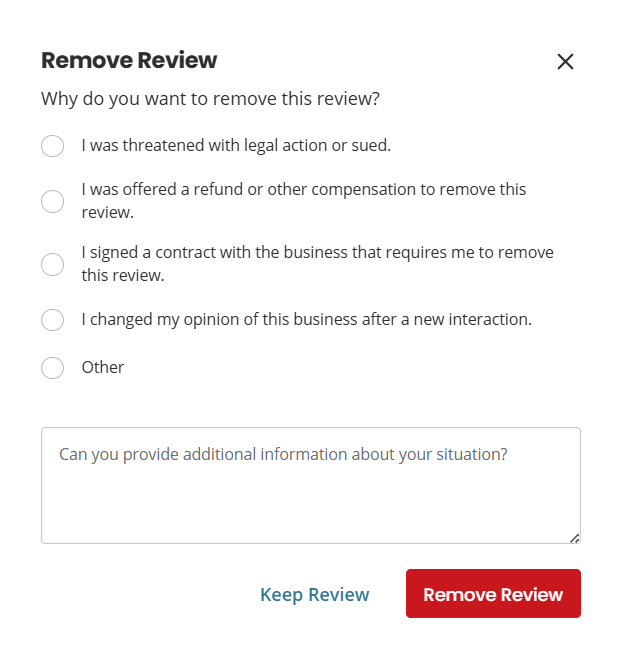
While it may be annoying to have negative (but factual) reviews on your Yelp profile, focus on how you can explain and improve your experience based on the feedback, rather than spending energy trying to get them removed.
How does Yelp handle fake reviews?
Yelp says that it’s a “community-driven site” and doesn’t take the removal of third-party content, such as images or reviews, lightly. It also says it won’t take sides in factual disputes.
However, Yelp has very strict guidelines on incentivizing reviews, whether that’s buying fake reviews by the dozen or just asking happy customers for reviews.
As part of its drive for fairness, Yelp has invested in a number of programs to weed out compensated and fake reviews, in line with UK and US legislation:
Consumer Alerts
Profiles suspected of benefiting from fake or paid reviews may have a Consumer Alerts pop-up applied. The pop-up warns users that abnormal activity—which may be an attempt to mislead them—has been detected on the profile in question after a review of available evidence.
Alerts may tell consumers that there’s evidence of suspicious review activity or evidence of compensated reviews.
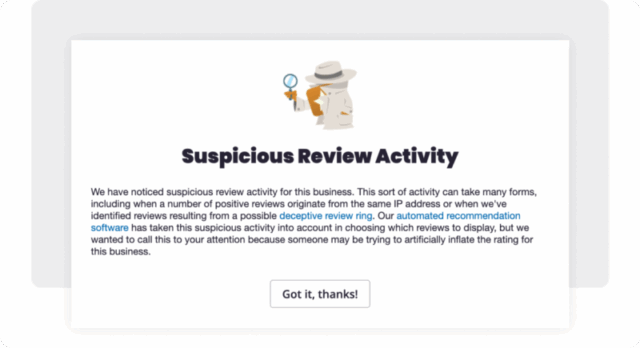
Picture credit: Yelp
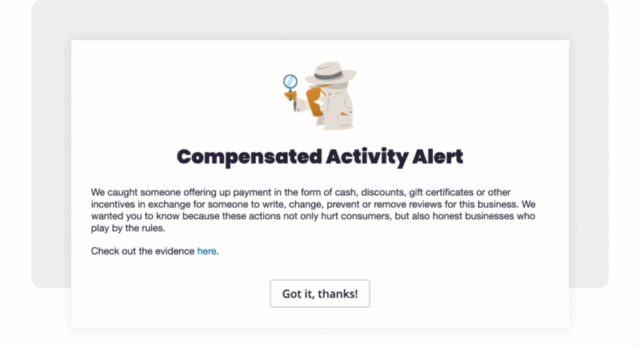
Picture credit: Yelp
Yelp displays all of the businesses it catches paying for or incentivizing reviews on its Consumer Alerts wall of shame (or Previous Compensated & Suspicious Review Activity Alerts, to give it its proper name), complete with screenshot evidence of the infraction. You don’t want to end up there!
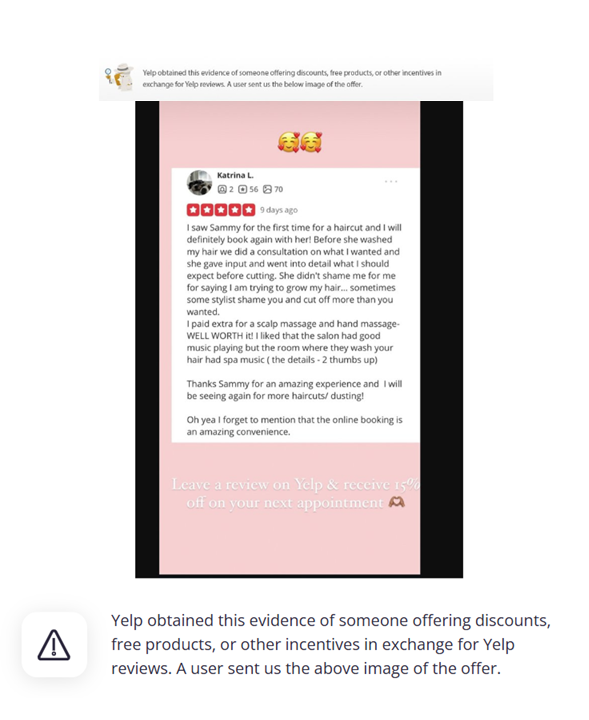
Recommendation Software
Yelp’s Recommendation Software evaluates each review left for a business profile. It analyzes billions of data points to identify the most helpful reviews and then recommends those to users. This means fake reviews could lack visibility.
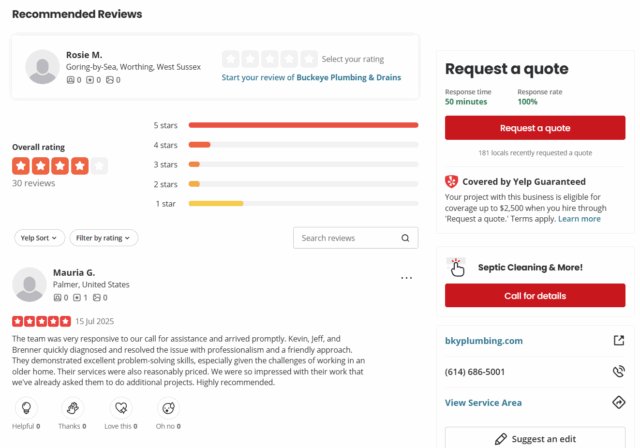
Human moderators
Yelp also has a team of human moderators who review potential issues flagged up by business owners, community users, or its own automated systems.
Yelp says it also monitors other platforms and the dark web for shady review behavior. In 2024, Yelp submitted more than 900 reports to sites, including Reddit, Facebook, and LinkedIn, warning of suspicious groups, posts, and individuals attempting to pay or trade for reviews.
How do I remove fake Yelp reviews?
Getting Yelp reviews removed is not a cut-and-dried process. A good strategy is to approach the review as genuine, while also looking for any evidence that it’s fake or malicious.
1. Responding to bad Yelp reviews
The temptation will be to rush in quickly with a strongly worded reply. Resist that urge!
Poorly-worded review responses can quickly create a negative impression of your business and put other customers off. In the worst-case scenario, they could also go viral, creating exactly the kind of publicity you don’t want for your business.
You’ll need to keep a cool head and show that you’ve tried addressing the bad review in a constructive and professional way.
- If you have a record of that customer, try connecting with them offline to fully understand the issues that led to the poor review.
- If you can’t find contact information, leave a (very) polite reply thanking the customer for their feedback, assure them that you wish to investigate further, and invite them to reach out so that you can work towards a resolution.
For a genuinely negative experience, you should impress the reviewer with your commitment to putting things right, allowing you to ask them to update (or even delete) the original review to give a more balanced opinion.
We’ve put together an article on dealing with negative reviews like a pro.
2. Deleting a malicious Yelp review
If the above fact-finding mission fails, then take comfort in knowing you’re now in a stronger position to report the review to Yelp as being false, defamatory, or malicious in nature.
Yelp has clear guidelines governing reviews left on the site. It specifies that reviews:
- Should be factually correct
- Should be based on the reviewer’s own first-hand experience
- Shouldn’t be based on old brand interactions
- Shouldn’t be promotional
- Shouldn’t represent a conflict of interest (for example, leaving a positive review for a friend’s business or a negative review of a competitor)
- Shouldn’t be exchanged for payment
Start with ‘Should be factually correct’. Collate as much information from your business records as you can, including your documented attempts to address their concerns as genuine.
See if you can prove that the review has a clear conflict of interest, such as a review left by a disgruntled former employee or a competitor.
Highlight any examples of inappropriate material, such as threats, hate speech, or harassment—either in the original review or in subsequent communications.
3. Report the fake review to Yelp
As noted above, fake reviews are big business in some corners of the internet, and they’re a pain to investigate if there’s no genuine information to cross-reference within your business.
Instead, make a strong case for removal by gathering evidence to present to Yelp:
- Dig into your client records to verify that they’re not a genuine customer. This shows that they’re in violation of Yelp’s requirement that all reviews relate to that person’s own experience of your business.
- Take a look at how many other reviews that person has left and for what businesses. A brand-new account with just your review is a strong indicator that it’s fake.
- Study the language and tone of the review. Is this mirrored on other reviews posted at the same time? If so, it could be a part of a wider fake review campaign.
- Check if you have a series of other bad reviews posted at the same time but by different usernames. This is a common tactic used by fake review spammers.
You’ll need to make sure you’re spotting fake and negative reviews quickly, as these could sway the opinion of potential customers if you’re too slow to respond or remove them. Keep a close eye on your Yelp listing, or invest in Reputation Management software to flag these up to you immediately if there’s a chance a damaging review may slip through the net.
Spotting fake Yelp reviews on competitors’ pages
Fake reviews aren’t just a problem on your own Yelp page. Sometimes, you may suspect competitors of using fake reviews to make their business look better on Yelp.
If you spot a review on a competitor’s page that seems fake, you can report it:
- Go to the review on Yelp.
- Click the three dots next to the review.
- Select “Report Review” and explain why it seems fraudulent.
Yelp will investigate against their Content Guidelines and Terms of Service and take action if necessary. Of course, it’s much harder to provide proof than if it’s your own business, but Yelp may be able to spot suspicious behavior and take down the fraudulent reviews.
How to submit a fake reviews report to Yelp
With your evidence gathered, you can now go ahead and submit a request for the offending review to be reviewed by the Yelp moderators.
Step 1: Claim your Yelp business profile
If you’ve not done so already, then the first step in removing Yelp reviews is to claim your business profile.
This is easy to do—go to Yelp For Business and follow the steps outlined. This blog post also provides more detailed instructions if you need help with this essential step.
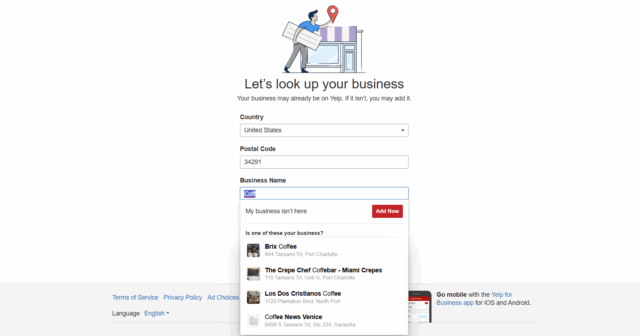
Step 2: Log in and find the review
Log in to your Yelp business account. From your dashboard, navigate to ‘Reviews’ and then scroll down to find the review you’re asking Yelp to remove.
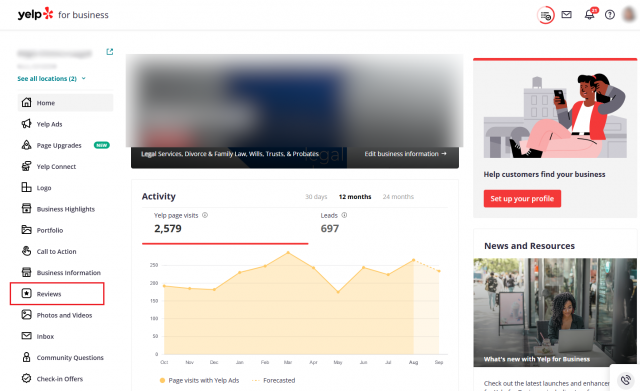
Step 3: Go to the ‘Report Review’ button
You’ll see three dots to the side of the review text. Click on those dots to pull up a menu and select ‘Report Review’.
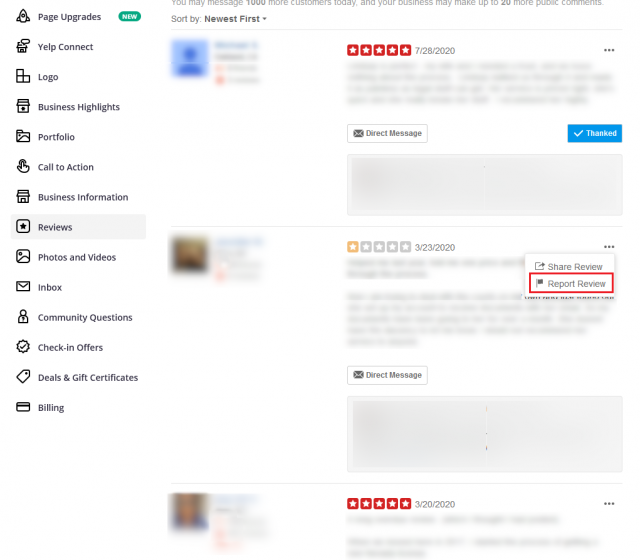
Step 4: Complete the form
Select the most appropriate reason for requesting the Yelp review removal and complete the form with as much information as possible. It will then be reviewed by the moderators.
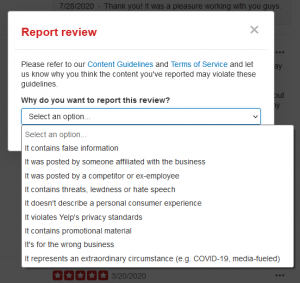
Step 5: Be patient!
Now comes the hard part…the wait! Yelp will inform you of the outcome of the investigation. In the event that the Yelp review is removed, the original author will also be informed.
This process can take several days, but either way, you should be notified of the result. In the meantime, you can hover over the flag icon next to the review to see the status of your report. If you don’t hear anything after a week or two, then contact Yelp directly with your case number to try and secure an update.
What if the review isn’t removed?
Yelp may not uphold your complaint. If that’s the case, the review will remain on your profile. You can try appealing, but you may still be out of luck.
While this is frustrating, your best course of action is to calmly and professionally respond to the review. Don’t make any big accusations about its legitimacy, but think carefully about how you can show readers that it’s unlikely to be from a real customer.
For more guidance on handling reviews and turning feedback into growth, check out our complete guide to online review management. It’s full of tips, strategies, and templates to help you build positive reviews and strengthen your reputation.